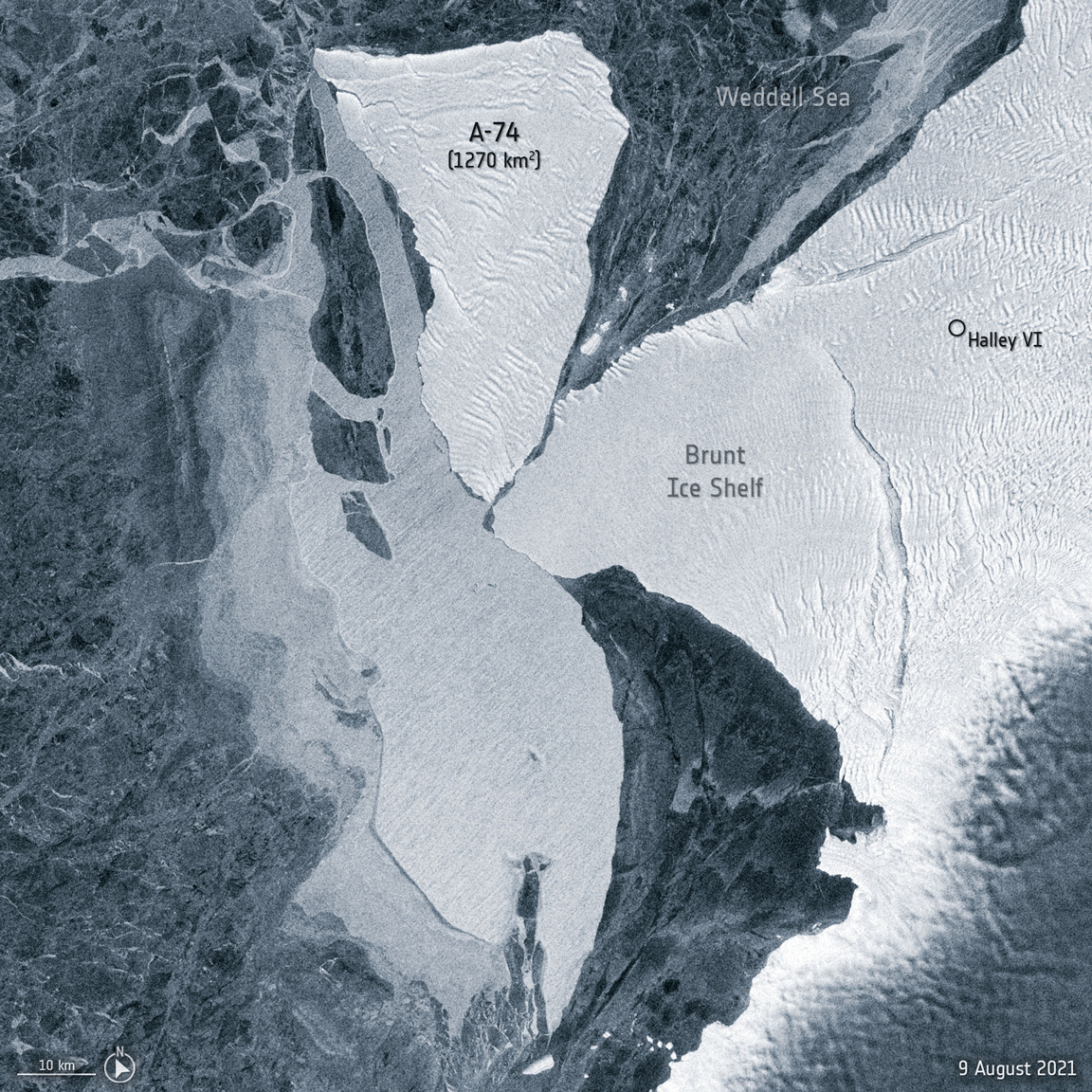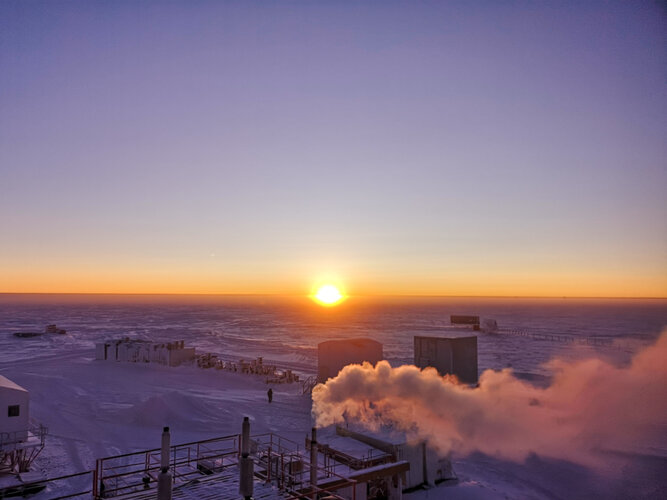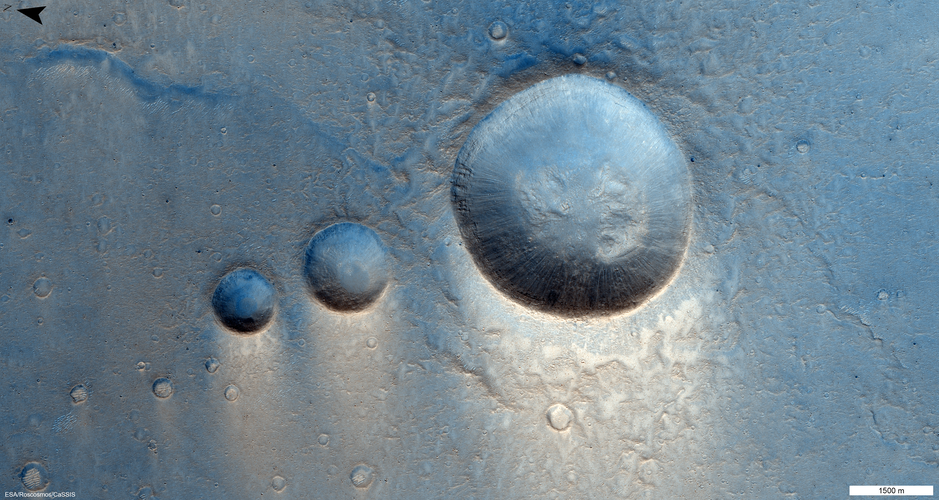Space News & Blog Articles
Image: New radar images show the A-74 iceberg spinning around the western tip of the Brunt Ice Shelf, brushing slightly against it before continuing southwards.

Image:
After four months of darkness, it is finally time to rise and shine for the crew at Concordia Research Station in Antarctica. The most-welcome Sun finally made its appearance on 11 August and ESA-sponsored medical doctor Nick Smith was not about to miss it.
For nine months Nick and his fellow crew mates have been living and working in one of the most isolated, confined and extreme environments on Earth, with no way in or out of the Station during the winter-over period.
Nick is overseeing experiments in human physiology and biology, atmospheric physics, meteorology, and astronomy, among other disciplines. Along with the rest of the crew, he is also maintaining the base – one of only three to run year-round in the Antarctic.
Four months of complete darkness is quite the challenge, and one researchers are very interested in studying from a physiological and psychological point of view. From questionnaires to blood and stool samples, the crew are poked and prodded to understand how better to prepare humans for deep space travel.
Social dynamics are also of interest to researchers during the period of darkness. Stress brought on by lack of sunlight, changing sleep patterns, fatigue and moodiness can affect the group. The crew are especially encouraged to take on group activities and get creative to combat the isolation of the winter. And not just with their own station crew.

Europe’s Vega has delivered Pléiades Neo-4 and four auxiliary payloads, SunStorm, RadCube and LEDSAT developed through ESA, and BRO-4, to their planned orbits.
Tune in to ESA Web TV from 02:37 BST / 03:37 CEST on 17 August to watch the Vega launch live.
Image: Parts of the Mediterranean and central Europe have experienced extreme temperatures this summer, with wildfires causing devastation on the Greek island of Evia. This Copernicus Sentinel-2 image shows the extent of the burned area in the northern part of the island.
Video: 00:00:57
A stunning sequence of 89 images taken by the monitoring cameras on board the European-Japanese BepiColombo mission to Mercury, as the spacecraft made a close approach of Venus on 10 August 2021.
The sequence includes images from all three Monitoring Cameras (MCAM) onboard the Mercury Transfer Module, which provides black-and-white snapshots in 1024 x 1024 pixel resolution. It is not possible to image with the high-resolution camera suite during the cruise phase. The images have been lightly processed to enhance contrast and use the full dynamic range. A small amount of optical vignetting is seen in the corners of some of the images.
The first image is from MCAM 1, and was taken at 13:41:02 UTC, prior to close approach. As such, the spacecraft was still on the nightside of the planet, but the dayside can just be seen creeping into view. Part of the spacecraft’s solar array can also be seen.
The second image was taken by MCAM 2 at 13:51:56 UTC, two seconds after closest approach. With the Venus surface just 552 km away, the planet fills the entire field of view. The camera is not able to image detail of the planet’s atmosphere. The image also captures the Mercury Planetary Orbiter’s medium gain antenna and magnetometer boom.
The rest of the sequence is from MCAM 3, while the spacecraft was pointed at Venus, and then as it slews away and gradually recedes from view, covering the time period 13:53:56 UTC on 10 August until 12:21:26 UTC on 11 August. The high gain antenna of the Mercury Planetary Orbiter is also seen changing orientation as it points towards Earth.

Video: 00:03:21
Meet bag, bottle and straw, three bits of plastic left on the beach.
They are only small, but they are heading into the ocean, where they could cause big damage. ESA is exploring how satellites can help detect and reduce plastic pollution in the ocean. From spotting build-ups of marine litter to tracking ocean currents, satellites could be game-changing in tackling this enormous environmental problem.
Though engaging for children and adults alike, this video is designed with 8–12-year-olds in mind. In particular, teachers can use it to introduce the topic of marine litter in subjects such as geography and science. A Dutch version will be available very soon.
This video was produced by the Discovery & Preparation elements of ESA’s Basic Activities.
Video: 00:09:41
The International Space Station Expedition 65 crew recorded themselves on a day off after a long week of work having some weightless fun. From Earth orbit, 400 km above our planet, the crew present the very first Space Olympics.
ESA astronaut Thomas Pesquet shared this video on social media with the caption:
“The first ever Space Olympics ! A Saturday afternoon on the International Space Station. Four disciplines. Rules that evolved as we played. Seven athletes. Four nations. Two teams. Crew cohesion and morale boosted like never before. The first Space Olympics saw Team Crew Dragon and Team Soyuz compete in lack-of-floor-routine, no-handball, synchronised space swimming and weightless sharpshooting.”
Over 200 experiments are planned during Thomas’ time in space, with 40 European ones and 12 new experiments led by the French space agency CNES. Throughout Mission Alpha Thomas is highlighting the parallels between being an astronaut and an athlete: both need to perform at key moments, and train hard to be at their best. Thomas has often said that sport taught him the values of team spirit and respecting team mates, and no astronaut is an island – if one profession is an example of teamwork it is being an astronaut. It takes a team to ensure they are at their best
Latest updates on the Alpha mission can be found via @esaspaceflight on Twitter, with more details on ESA’s exploration blog via thomaspesquet.esa.int.
With the first Copernicus Sentinel-2 satellite in orbit since 2015 and the second since 2017, engineers are busy preparing the mission’s follow-on pair to eventually pick up the baton to supply images for a myriad of applications from food security to monitoring the decline of Earth’s ice. Slated for launch at the beginning of 2024, Sentinel-2C has just started a punishing five-month testing programme to ensure that it is fit for its life in space.
Forests are not only key to moderating our climate by sequestering atmospheric carbon, but they also create a cooling effect by increasing low-level cloud. A first global assessment using satellite observations has shown that for two-thirds of the world, afforestation increases low-level cloud cover, with the effect being strongest over evergreen needleleaf forest.
Russia has the largest area of forest on the planet, with more than a fifth of the world's trees. A new study, led by Russian scientists using data from ESA’s Climate Change Initiative, has produced new estimates of biomass contained in Russian forests, and confirms that the vast forested area is storing more carbon than previously estimated.
Image: This map generated using data from Copernicus Sentinel-3 shows the temperature of the land surface on 2 August 2021.
Image: Captured by the Copernicus Sentinel-3 mission on 30 July 2021, this image shows smoke billowing from several fires along the southern coast of Turkey.
The first science tests for the ExoMars rover replica kicked off after several weeks of driving tests around the Mars Terrain Simulator at the ALTEC premises in Turin, Italy.
Solar Orbiter and BepiColombo are set to make space history with two Venus flybys just 33 hours apart on 9 and 10 August.


